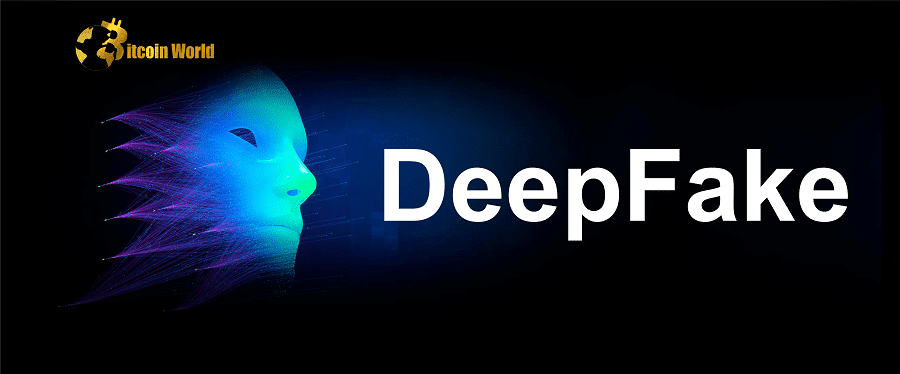In the fast-paced world of cryptocurrency, where fortunes can be made or lost in a blink, the pressure to react quickly to information is immense. But what if the information itself isn’t real? The rise of sophisticated “deepfake” technology poses a significant threat to crypto investors, blurring the lines between reality and fabrication. Are you prepared to spot a fake before it’s too late?
The Growing Threat of Deepfakes in Crypto
Imagine seeing a video of a prominent crypto figure announcing a major change or urging you to invest in a new project. Your immediate reaction might be to act fast. However, according to David Schwed, COO of blockchain security firm Halborn, this urgency makes the crypto space particularly “vulnerable” to deepfakes. The limited time for decision-making leaves investors with less opportunity to verify the authenticity of a video message.
So, what exactly are deepfakes? Vlad Estoup, a technical writer at OpenZeppelin, explains that these are highly realistic digital creations powered by deep learning artificial intelligence (AI). This technology can manipulate existing videos, images, and audio, even swapping faces to create convincing yet entirely fabricated content.
How Are Deepfakes Used to Scam Crypto Investors?
Unfortunately, crypto criminals are leveraging deepfake technology to create fake videos featuring well-known personalities to promote fraudulent schemes. A prime example highlighted by the original article involved scammers using old interview footage of FTX’s former CEO, combined with a voice emulator, to lure users to a fake website promising to double their Bitcoin. This illustrates the deceptive power of these fabricated videos.
Why Are Crypto Investors Particularly Susceptible?
The inherent volatility of the cryptocurrency market plays into the hands of deepfake scammers. As Schwed points out, the fear of missing out (FOMO) or the panic selling during market downturns can drive investors to make hasty decisions without proper verification. Consider this scenario:
“If a video of CZ is released claiming withdrawals will be halted within the hour, are you going to immediately withdraw your funds, or spend hours trying to figure out if the message is real?”
This highlights the critical dilemma faced by crypto investors when confronted with seemingly urgent information.
Is All Hope Lost? Can You Really Spot a Deepfake?
While deepfake technology is rapidly advancing, experts believe it’s not yet entirely foolproof. Estoup assures us that deepfakes are not yet “indistinguishable from reality.” This gives us a fighting chance to identify them.
Your Deepfake Detection Toolkit: Practical Tips
So, how can you arm yourself against these sophisticated scams? Here are some actionable steps:
- The Blink Test: Schwed suggests a quick initial check – observe the person’s blinking. Deepfakes often struggle to replicate natural blinking patterns due to the training data being primarily images with open eyes. Unnatural or infrequent blinking can be a red flag.
- Ask the Unaskable (For Them): The most reliable method, according to Schwed, is to ask specific questions that only the real person would know the answer to. Think of personal details or shared experiences.
- Leverage AI Against AI: Estoup points out the existence of AI-powered deepfake detection software. Keep an eye on advancements in this field as it offers a technological defense against AI-generated fraud.
- The Golden Rule: Remember the age-old adage: “If it sounds too good to be true, it often is.” Be wary of unbelievable promises or guarantees.
Real-World Examples: Even the Experts Get Targeted
The threat of deepfakes is so pervasive that even prominent figures in the crypto world have become targets. Patrick Hillman, Binance’s chief communications officer, shared his experience in an August blog post. A sophisticated deepfake of him was created using past interviews and appearances, successfully fooling some experienced crypto professionals. He only became aware of the deepfake after receiving messages thanking him for discussing potential listings on Binance.com. This serves as a stark reminder that anyone can be a victim.
The Broader Landscape of Crypto Crime
Deepfakes are just one piece of the puzzle in the fight against crypto crime. A report by blockchain security firm SlowMist revealed 303 blockchain security incidents in 2022, with phishing, rug pulls, and other scams accounting for a significant 31.6% of these events. This underscores the importance of vigilance and continuous learning about the evolving tactics of cybercriminals.
Staying Ahead of the Curve: What’s Next?
The battle against deepfake scams is an ongoing one. As technology evolves, so too will the methods used by both scammers and those fighting against them. Here are some key takeaways to keep in mind:
- Be Skeptical: Approach all online information, especially videos promoting investments, with a healthy dose of skepticism.
- Verify Sources: Always cross-reference information from multiple reputable sources before making any decisions.
- Stay Informed: Keep up-to-date with the latest news and trends in crypto security and deepfake detection.
- Trust Your Gut: If something feels off or too good to be true, it probably is.
The Bottom Line: Your Vigilance is Your Best Defense
Deepfake technology presents a serious and evolving threat to crypto investors. The speed and complexity of the crypto market, combined with the convincing nature of these AI-generated fakes, create a perfect storm for scams. However, by understanding the tactics used by fraudsters, staying informed about detection methods, and maintaining a healthy level of skepticism, you can significantly reduce your risk of becoming a victim. Remember, in the world of crypto, vigilance is not just a virtue, it’s a necessity for protecting your investments.
Disclaimer: The information provided is not trading advice, Bitcoinworld.co.in holds no liability for any investments made based on the information provided on this page. We strongly recommend independent research and/or consultation with a qualified professional before making any investment decisions.


